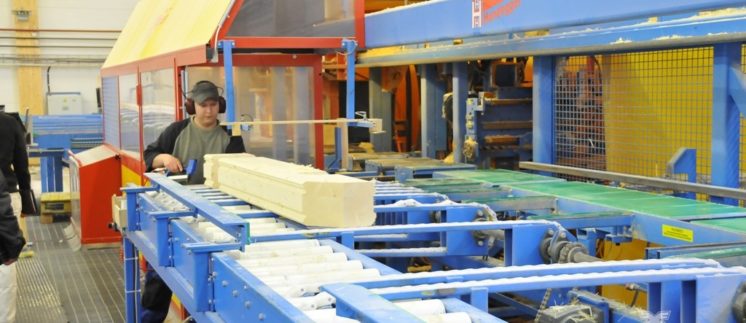
Glued laminated timber technology provides several advantages
All good things are good for a specific reason. This also applies to glued laminated timber. What is the peculiarity of the glued laminated timber used in the houses of Finnlog and what makes us confident that we can recommend our product?
If you take a quick look at the glued laminated timber of different manufacturers, there are no great differences at first glance. As the name indicates, glued laminated timber is made by gluing together lamellas. The quality of glued laminated timber depends on the quality of the wood, the moisture content of the wood, and the gluing technology. All of these components are very important for Finnlog, but special attention is paid to the gluing technology.
The cold press or hot press technology is mostly used for making glued laminated timber. This is a relatively labour-intensive process. The factory which delivers the material to Finnlog uses a technology which involves radio waves at certain wavelengths being directed through the glue layer. This wave results in a quick change in the polarity of the hydrogen molecules in the glue layer and activates the responses required for gluing. The main advantage of this gluing technology is that the moisture content of the wood lamellas glued can be low, only about 15%. The wood material is constantly kept at the right moisture level in the factory, as this is the prerequisite for achieving the required quality. In the case of many other gluing technologies, however, the moisture content of the wood required for gluing needs to be significantly higher for the gluing process to even take place. This results in a situation where the glued laminated timber with a higher moisture content will dry more later in indoor conditions, causing more extensive deformations in the wood.
Furthermore, the wood material used in the construction of the houses of Finnlog is also subjected to stringent quality controls. There is a thorough preliminary selection process and the wood material is purchased from the best suppliers based on specific quality criteria. The wood material is sorted carefully and the lamellas used for each glued laminated timber log are selected based on a specific principle. The denser heartwood is always placed on the outside in a glued laminated timber log, as it takes a long time to dry and does not cause the wood to crack quickly. The inner lamellas of a glued laminated timber log, however, are placed with the heartwood pointing alternately outwards and inwards to balance the log. This kind of placement of the lamellas in a glued laminated timber log helps the log to remain more stable when the moisture concentration of the wall structure changes and helps to prevent the cracking of the surfaces of the logs in the longer term.
The quality of the glued laminated timber is also improved significantly by removing any damaged spots in the course of preparing the wood lamellas, if necessary – a piece of the lamella is cut out and only the wood material with a suitable quality is used.
Spruce or pine is used as the wood material for the houses of Finnlog. Spruce is lighter and its colour changes little in time. Pine, however, turns yellow in time.
Finnlog uses a unique conveyor system for gluing lamellas, in which prepared lamellas are glued in five-metre sections. This mechanical conveyor system allows to produce large volumes from the technological perspective and is also simple and efficient, as the amount of manual work required is small. The glued laminated timber of the houses of Finnlog is precisely cut to size in the factory and therefore easy to use in construction.
All of the above ensures that a glued laminated timber house of Finnlog is of a high quality, durable, and allows to grant a warranty of as much as ten years for the structure of the house.
